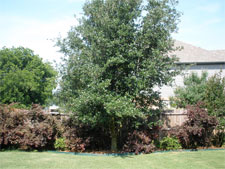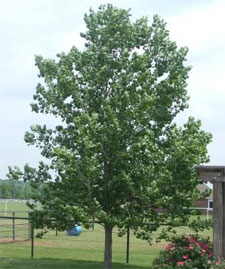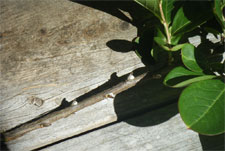Question and Answer – June 2010
Question: What is your opinion on this live oak? I’m afraid I waited too long to prune it to remove the "trashy trunk." Should I remove the larger ones this winter, or is it a better idea simply to remove some of the lower small branches from them? I’d like the tree to have a higher canopy. M., Rockwall.
Answer: Your tree is well beyond where you need to worry about trashy-trunk. (For the uninitiated, that is the practice of leaving 6-inch stubble of pecan or live oak branches to nourish the trunk, so that it will thicken up more quickly.) Remove the branches one at a time, beginning with the lowest and least important one among them. From your photo, it would seem to be the one going off to the left. The slightly larger branch off to the right opposite the first branch probably should be removed, too. However, the only way to be sure would be to tie a long, soft rope around that branch out toward its end. Pull down on it gently, to see what visual impact its removal might have. If it’s not needed, cut it off virtually flush with the trunk. Leave one-quarter inch of the branch "collar" to help it heal more quickly. Then, stair-step your way up the trunk until you’ve removed as many branches as you wish to remove. I agree, you do need to make these cuts. Remember that oak wilt is always a threat when you have cut surfaces. Certified arborists and pathologists tell us not to prune during the spring. Wait until it’s really hot in mid-July, or wait until mid-winter. Seal cut surfaces with a light coating of pruning sealant.
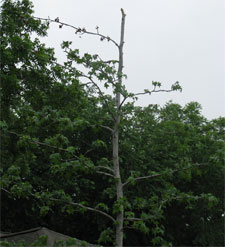
Question: My sweet gum was in the wrong place, and we had to have it moved about 18 months ago. We hired a tree service company to dig it with a large soil ball. Last year it suddenly dropped most of its leaves, and this year, it looks like it’s dying. What can I do to help it? C.D., Euless.
Answer: Hopefully we can still be friends after my answer. Your tree is suffering terrible transplant shock, and the odds are very strongly against its surviving. Sweet gums aren’t that easy to move in the first place, but you did all you could to help it. The leaf drop last year, and the dieback this year are both due to the severe loss of roots during the moving. If anything would help it, it would be to cut half or more of its top growth back to compensate for that root loss, but that probably won’t be help enough at this point. You’d be time and dollars ahead just to replace it with a new tree. Thanks for all the care you’ve shown for it, and I’m sorry for the message.
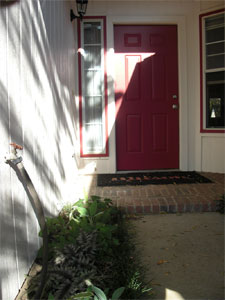
Question: I have this area near my front door. It gets about two hours of sunlight, if that much. In the past, everything I put there has seemed to lean and look ugly. What ideas might you have? T.R., no city given.
Answer: That’s not enough width for any type of shrub. Plus, even if shrubs would grow there, they would grow exactly as you described. If this were my plot, I would use the wall as a support for some really pretty hanging garden art, wall pots, etc. I’m sensitive to the fact that your wall cannot stay wet. Consider a decorative, wall-sized piece of wrought iron mounted a few inches out from the wall. You could attach bromeliads, wall pots of trailing/vining foliage plants and garden art such as sun faces or stained glass directly to it. The options are almost limitless. You could use dwarf mondograss as a neutral groundcover at its base, and you could find some very pretty mid-sized (golf-ball- and tennis-ball-sized) river rocks to cover the soil. Woody plants are going to lean away from the darkness of the wall, so they’re never going to be satisfactory for you. Or, you might put decorative gravel or rock in the bed, then place attractive 14- and 16-inch pots atop the stones. Grow herbs, tropicals and shade-loving annuals in the pots. Maybe something in all of that will be of help.
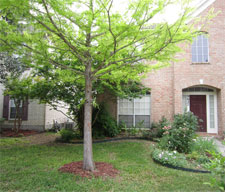
Question: We are concerned about the bald cypress tree our builder planted in our yard about 15 years ago. It’s about 20 feet tall, and it has a trunk diameter of 7 or 8 inches. A neighbor recently got rid of a similar tree. We’ve seen the big ones with all their knees along the River Walk here, and we’re wondering if we should take this one out? M., San Antonio.
Answer: I’ve walked the River Walk many times, and I know those trees very well. Your tree is not likely to develop to the same size as those downtown, and knees are not likely to be a concern. The conditions in an upland landscape are quite different. In fact, this tree looks like it is suffering from iron deficiency. If it traditionally stays light yellowish green, getting worse as the summer progresses, that’s the fate they commonly encounter in alkaline soil areas. While one would think you could add iron to solve the problem, it eventually becomes impossible to get enough iron into these trees. Many years ago, I decided to be honest and to advise people to replace their trees if they’re afflicted with iron chlorosis in highly alkaline areas. Do ask others’ opinions, however. Local independent retail nurserymen would be good sources of help. Look for a Texas Master Certified Nursery Professional.
Question: Is it possible to cut off the parts of a cottonwood tree that produce the cotton BEFORE it starts producing? Will this harm the growth of the tree? K.B., Burleson.
Answer: Every branch of each cottonwood tree will produce the puffy clouds of seeds once it reaches bearing age. Unless you’re willing to climb to the top of a 50-foot-tall tree, then out on each limb, it’s going to have cotton. For the record, cottonless cottonwoods are propagated from cuttings, so they will maintain their fruitless nature.
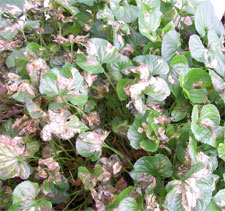
Question: Can you tell what is eating my sweet violets? It happened last year. The plants looked terrible all summer, but they bounced back in the fall. What causes this? I tried a systemic insecticide without results, then I used horticultural oil and they got a lot worse. D.F., Plano.
Answer: I can’t tell from the photos, because most of the browning looks like it could have been caused by sunscald after the oil spray. I zoomed in on the photo four or five times, and I’m sure spider mites are involved. If you notice very fine stippling that turns patches of the leaves manila-folder tan, that’s the spider mites’ work. Thump one of those leaves over white paper, and you’ll see tiny specks starting to move around after a few seconds. We no longer have a specific miticide. The systemic product that you used should help, but the plants will probably go downhill a while before they bounce back.
Question: I have these white insects on the trunks of my crape myrtles. What are they, and what can I do to control them? B.C., Irving.
Answer: We have more detail on this at the Crape Myrtle Trails of McKinney website. These are scale insects, and the jury is still out on how serious they will be. They’re more prolific in cool, wet springs like we’ve had in recent weeks. Systemic insecticides work well on them. There is also a ladybug that feeds specifically on this pest. It’s a black ladybug with two orange spots on its wings. The one year when these were serious (2007), the ladybug population grew overnight, and they ate scales like vacuum cleaners. One way or the other, you want to eliminate the scale before it starts secreting sticky honeydew residue all over the leaves. Black sooty mold will grow in the honeydew if it’s left unchecked.
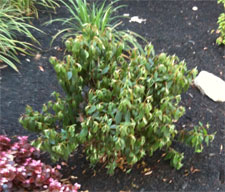
Question: Why would my new Encore azalea look so droopy? It does this every day, as if it were dry, but it isn’t. By the next morning, it looks fine once again. M.B., Cypress.
Answer: When a plant that is growing in moist soil wilts in mid-day sunshine, that’s good indication that it isn’t able to pull water through quickly enough to meet the needs it faces when the sun hits it. I have 30-year-old oakleaf hydrangeas that do the same thing. They look like they are absolutely parched, yet they bounce right back again as soon as the sun passes over them, whether I water them or not. This plant does look like it’s struggling more than it should. Be sure you hand-water it between sprinkler irrigations. It will dry out more quickly than the adjacent soil.
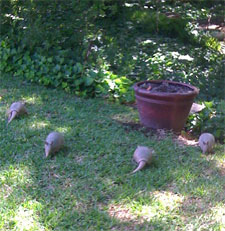
Question: What can be done with armadillos? I have no problem with the coyotes, bobcats and possums we’ve had in our yard. These things are the most destructive, and here comes the next generation. What can I do? E.E., no city given.
Answer: Oh, you poor gardener. We have a similar issue. I have a humane trap that was given to me (home-made) many years ago. We have used it to capture almost 60 of these pests. We release them along a flood plain several miles away. Our secret in capturing them is to find their paths and hopefully their tunnels, then to place the trap in direct line. We use a 20-foot piece of chicken wire on both sides of the trap, as a funnel, to guide them into the trap. If we fail after a few nights, we move the trap. Humane traps that work for raccoons will probably work for armadillos. We occasionally capture a possum instead. My, those possums can really be friendly!
Question: One of my oak trees suffers at least one broken limb of 2 or 3 inches every winter. I have three other oaks that never seem to be bothered. What is this type of oak, and what can I do to help it? C.A., Red Oak.
Answer: Your city name is the proper I.D. – Shumard red oak, native throughout much of North Central Texas. It’s generally a great shade tree, but yours does appear to have some narrow, weak branch angles. You really ought to consider a certified professional arborist. Cabling and selective pruning may be advised. This is probably not a task that a non-professional should attempt.
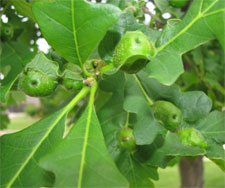
Question: What is wrong with our bur oak tree? Will these growths hurt it at all? S.W., no city given.
Answer: These are one of the many types of galls that attack oaks. You’re perhaps familiar with the wooly oak galls on the backs of live oaks’ leaves, also the woody oak galls that look like wooden marbles on the twigs of live oaks. There are hundreds of different galls. None is serious, and there is no reliable control for any of them. Just ignore them.
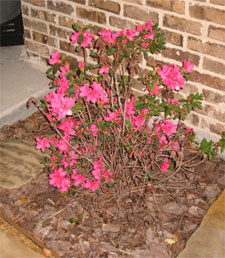
Question: We planted two Encore azaleas a year ago. They’re on the sunny west side of our house. (I knew they did better with morning sun and afternoon shade, but we wanted them near the back porch.) Last summer, one of them finally succumbed, branch-by-branch. Now, this one is struggling. Any idea what could have caused this? Photo is from five or six weeks ago, and you can already see its decline. A.K., Ennis.
Answer: That’s too hot for azaleas. They can’t handle the sun and heat, plus it looks like your bed might catch and retain rainfall. Azalea roots will deteriorate in waterlogged soils. You’d be much better served by a nice decorative pot filled with a flowering annual that would bloom in the sun, and that would do so for months on end. We have several nice choices. Talk to your nurserymen.


